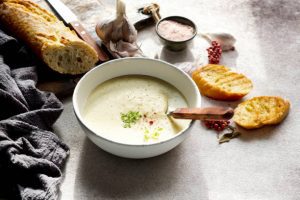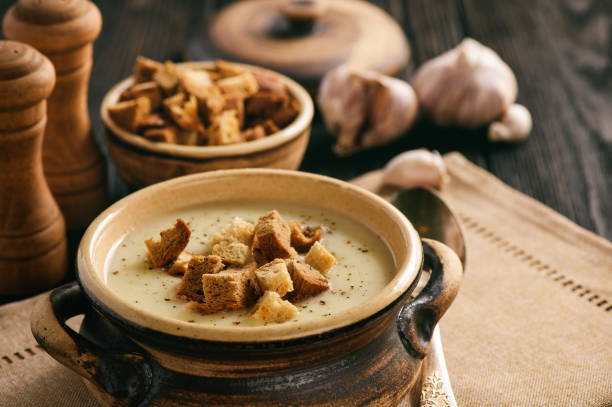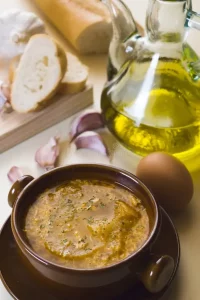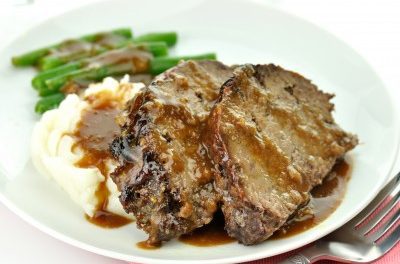Castilian Garlic Soup (Sopa de Ajo)
Prep Time: 10 minutes
Soak Time: 0 minutes
Cook Time: 30 minutes
Total Time: 40 minutes
Servings: 4
A little history
Garlic soup shows up across Europe, but the most iconic version is Spain’s sopa de ajo, a staple of Castile and León. Born as peasant sustenance, it turned humble pantry scraps—stale bread, garlic, olive oil, and water or stock—into fortifying comfort. Smoked paprika (pimentón), introduced to Spain after New World chiles, gave the broth its brick-red hue and smoky depth. Tavern keepers and shepherds adopted the soup for its economy and warmth; in Holy Week it appeared meatless, and in colder months it gained a poached egg for protein. Cousins exist elsewhere—Provençal aïgo boulido and Gascon tourin—but the Spanish balance of garlic, paprika, olive oil, bread, and egg is uniquely satisfying and endures from farmhouse kitchens to modern tapas bars.
Ingredients
- 8–10 cloves garlic, thinly sliced
- 4 tbsp extra-virgin olive oil
- 1 tsp smoked paprika (pimentón dulce)
- 1 small pinch cayenne or pimentón picante (optional)
- 4 cups chicken or vegetable stock (good quality)
- 4 oz stale rustic bread, torn into bite-size pieces (about 4 cups loosely packed)
- 1–2 tbsp dry sherry or sherry vinegar (to taste)

- Salt and black pepper, to taste
- 4 eggs (one per bowl)
- To finish: more olive oil, chopped parsley, extra bread for toasts
Directions
- Bloom the garlic: Warm olive oil in a medium pot over medium-low heat. Add garlic and cook gently 3–4 minutes until tender and just golden at the edges—do not brown deeply or it will turn bitter.
- Spice the oil: Stir in smoked paprika (and cayenne, if using) for 10–15 seconds to bloom in the oil.
- Broth and bread: Immediately add stock to halt the paprika’s cooking. Bring to a simmer, then add the torn stale bread. Season with a pinch of salt and pepper.
- Simmer and thicken: Cook 10–12 minutes, stirring and pressing the bread so it softens and releases starches, thickening the broth to a velvety, spoon-coating texture. If too thick, splash in more stock or water; if thin, simmer a few minutes longer.
- Balance: Off heat, add sherry (or a teaspoon or two of sherry vinegar) to brighten. Taste and adjust salt and pepper.
- Eggs: Return to a bare simmer. Crack eggs directly into the gently bubbling soup, spacing them out. Cover and poach 3–4 minutes until whites set and yolks are still soft (or longer to your liking).
- Serve: Ladle into warm bowls with an egg in each. Drizzle with a thread of olive oil, scatter parsley, and offer crisp toasts or extra bread on the side.
Tips, swaps & make-ahead
- Stock matters: A clean, low-salt stock lets garlic and paprika shine.

- Bread choice: Country-style or sourdough bread with yesterday’s firmness holds structure yet thickens well. Gluten-free rustic loaves work, too—dry them slightly in a low oven before adding.
- Egg alternatives: For a Lenten/vegan bowl, omit the egg and finish with a swirl of good olive oil and toasted almonds for protein and crunch.
- Flavor pivots: Add a pinch of saffron for floral depth, or a little roasted garlic alongside the sliced fresh for layered sweetness.
- Leftovers: The soup keeps 2–3 days refrigerated (without eggs); reheat gently and poach fresh eggs to serve.
This bowl is proof that economy and elegance can coexist: toasty garlic, gentle smoke, silky broth, and the richness of a soft-yolk egg—comfort in minutes from what you already have on hand.
References
- Serious Eats — “Castilian Garlic and Bread Soup (Sopa de Ajo)” (technique, paprika, poached egg) — https://www.seriouseats.com/castilian-garlic-and-bread-soup-sopa-de-ajo-recipe
- NYT Cooking — “Castilian Garlic Soup (Sopa de Ajo)” — https://cooking.nytimes.com/recipes/1012884-castilian-garlic-soup-sopa-de-ajo
- Saveur — “Castilian Garlic and Bread Soup” — https://www.saveur.com/article/Recipes/Castilian-Garlic-and-Bread-Soup/
- The Spruce Eats — “Spanish Garlic Soup (Sopa de Ajo) Recipe” — https://www.thespruceeats.com/spanish-garlic-soup-recipe-3083408
- Harold McGee — On Food and Cooking (garlic chemistry, flavor development) — Harvard Book Store — https://www.harvard.com/book/on_food_and_cooking/






